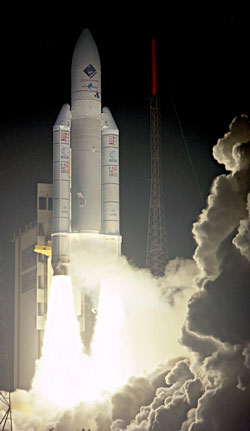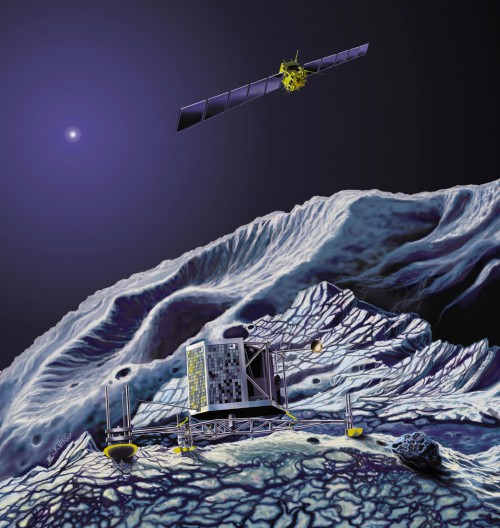
A handsome prince, in the form of the European Space Agency (ESA), has planted a tender kiss on the lips of a sleeping princess, 418 million miles (673 million km) from the Sun. Yesterday it was triumphantly announced that the Rosetta spacecraft had been successfully reawakened after 31 months in deep-space hibernation, and its decade-old mission is now back on track and closing in on an exciting conclusion: to orbit and land on the surface of Comet 67P/Churyumov-Gerasimenko. The first signal from Rosetta was received by NASA’s 230-foot (70-meter) Deep Space Network (DSN) antenna at Goldstone, Calif., at 6:18 p.m. GMT (1:18 p.m. EST), during the first “window” of opportunity it had to contact Earth. The triumphant revival of the spacecraft prompted the European Space Operations Centre (ESOC) in Darmstadt, Germany, to tweet the message everyone had waited so long to hear: “Hello, world!”
Launched in March 2004, aboard a mighty Ariane 5 booster from the Guiana Space Centre in Kourou, French Guiana, Rosetta consists of an orbiter, laden with 12 scientific instruments, and the Philae landing craft, which carries nine additional instruments. Named in honor of the Rosetta Stone—the discovery of which enabled Egyptologists to decipher ancient hieroglyphs—and the Nile island of Philae, whose obelisk helped to decipher the Stone, the mission is expected to decipher the history, composition, and evolution of a virtually untouched, primordial cometary object in unprecedented detail.
After departing Earth, Rosetta undertook a lengthy flight profile, whose convoluted trajectory carried it past the Home Planet on three separate occasions (in March 2005, November 2007, and November 2009), once past Mars (in February 2007), and past the asteroids Šteins in September 2008 and Lutetia in July 2010. Most recently, in June 2011, it was placed into a power-saving hibernation, and in that state it remained for 31 long months, as it drifted up to a maximum of 500 million miles (800 million km) from the Sun. Its solar arrays were oriented in such a manner as to receive as much solar energy as possible, and it was placed into a spin-stabilized mode. “Only the computer and several heaters” remained active, according to ESA at the time, “automatically controlled to ensure that the entire satellite doesn’t freeze.”

Now that Rosetta’s orbit has carried it back toward the Sun, it is at a distance which offers sufficient solar energy to begin powering all of its systems once again. The spacecraft’s internal clock was set to start the process of reawakening Rosetta at 10 a.m. GMT (5 a.m. EST) Monday, 20 January. “Once it wakes up,” explained ESA, “Rosetta will first warm up its navigation instruments and then it must stop spinning to point its main antenna at Earth to let the ground team know it is still alive.” Mission Manager Fred Jansen described his team’s anxiety to assess the spacecraft’s health after almost a decade in space and more than 2.5 years in a state of deep freeze and deep sleep. It is now less than 5.5 million miles (9 million km) from Comet 67P/Churyumov-Gerasimenko and will draw nearer with a major maneuver due in late May. This will position it for a rendezvous and a lengthy mapping phase in August and for the deployment of the Philae landing craft in November.
According to ESA, the vast distance between Rosetta and Earth meant that radio signals from the spacecraft took 45 minutes to reach the Goldstone DSN antenna. “The first opportunity for receiving the signal on Earth is expected between 17:30 GMT and 18:30 GMT,” it was noted last week. After a tense day at ESOC, it was 6:18 p.m. GMT (1:18 p.m. EST) when the confirmation of Rosetta’s good health finally reached the ears of controllers in Germany. “This was one alarm clock not to hit snooze on,” quipped Jansen. “We are absolutely delighted to have our spacecraft awake and back online.”
Added Alvaro Giménez, ESA’s Director of Science and Robotic Exploration: “With Rosetta, we will take comet exploration to a new level. This incredible mission continues our history of ‘firsts’ at comets, building on the technological and scientific achievements of our first deep-space mission, Giotto, which returned the first close-up images of a comet nucleus as it flew past Halley in 1986.”
Although several previous missions have observed comets from afar and even pummelled their surfaces—Comet Kohoutek was photographed extensively by the final Skylab crew, Deep Space 1 acquired astonishing imagery of the hot, dry Comet Borrelly 1, Stardust collected crystalline, “fire-born” material from Comet Wild 2, and Deep Impact spectacularly blasted a man-made crater into Comet Tempel 1—Rosetta and Philae will mark the first time that a machine fashioned by human hands has gone into orbit around a comet and deposited a landing craft onto its icy surface. “All other comet missions have been flybys, capturing fleeting moments in the life of these icy treasure chests,” said Matt Taylor, ESA’s Rosetta project scientist. “With Rosetta, we will track the evolution of a comet on a daily basis and for over a year, giving us a unique insight into a comet’s behavior and ultimately helping us to decipher their role in the formation of the Solar System.”
Regarded by ancient peoples as bringers of doom or impending destruction—and perhaps most famously illustrated in the Bayeux Tapestry as a harbinger of King Harold II’s death on the field of Hastings in October 1066—comets are today much better known, thanks to our mechanical emissaries. They are widely considered to represent the Solar System’s primitive building blocks and most likely helped “seed” Earth with water and maybe even the biological ingredients for life. Rosetta’s first images of the relatively unknown Comet 67P/Churyumov-Gerasimenko are anticipated in early May, by which point the spacecraft will be about 1.2 million miles (2 million km) from its quarry. A major maneuver later that same month will set Rosetta up for its critical rendezvous in August.
And after that, the truly exciting final phase of the mission will be just getting started. For two months the spacecraft will extensively map the surface of Churyumov-Gerasimenko and gather important measurements of its gravity, mass, shape, and the nature of its gaseous tail, or “coma,” probing its plasma environment to understand how it interacts with the solar wind. The results of this data will enable mission managers to choose an appropriate landing spot for the box-like Philae, which is currently planned to touch down somewhere on the comet’s surface on 11 November … just 294 days from today.

Once in place, and secured by a pair of harpoons and drills to prevent it from bouncing off the surface of comet—whose physical diameter is no more than 2.5 miles (4 km)—Philae’s payload of scientific instruments will examine the nucleus and perform a detailed chemical and mineralogical survey. “Among its wide range of scientific measurements,” explained ESA in a news update, “Philae will send back a panorama of its surroundings, as well as very high-resolution pictures of the surface. It will also perform an on-the-spot analysis of the composition of the ices and organic material, including drilling down to 9 inches (23 cm) below the surface and feeding samples to Philae’s on-board laboratory for analysis.”
In its first incarnation, Rosetta was not destined for Churyumov-Gerasimenko at all. Originally scheduled to begin in January 2003, the mission was targeted for an eight-year voyage to rendezvous with Comet 46P/Wirtanen—which measures only about 0.75 miles (1.2 km) in diameter—but an Ariane 5 failure in December 2002 grounded Rosetta’s launch for almost 14 months. As a result, Churyumov-Gerasimenko, which, at 2.5 miles (4 km), is significantly larger than Wirtanen, was selected instead. Its 6.45-year orbital period of the Sun carries it as close as 1.2 Astronomical Units (111.5 million miles or 179 million km) and as far as 5.7 Astronomical Units (530 million miles or 850 million km) from our parent star. Rosetta and Philae are expected to study the comet until the planned end of their mission in December 2015.
During that year-long period, known as the “escort phase,” Rosetta will follow Churyumov-Gerasimenko as it moves closer to the Sun, monitoring the ever-changing physical conditions on its surface as it warms up and its ices sublimate directly from solids to gases. “We have a busy few months ahead preparing the spacecraft and its instruments for the operational challenges demanded by a lengthy, close-up study of a comet that, until we get there, we know very little about,” said Andrea Accomazzo, ESA’s Rosetta operations manager.
Want to keep up-to-date with all things space? Be sure to “Like” AmericaSpace on Facebook and follow us on Twitter: @AmericaSpace



